National Flower
Blue Poppy (Meconopsis gakyidiana), Bhutan's national flower, is a symbol of the country's unique and pristine natural beauty. This rare and exquisite flower thrives in the moist, high-altitude regions of the Himalayas, particularly in Bhutan, where it is found at elevations of 3,000 to 4,500 meters. Blue Poppy is renowned for its strikingly vibrant blue petals, which stand out against the rugged mountain landscapes, making it a breathtaking sight for trekkers and nature enthusiasts who visit these remote areas during its blooming season from June to July.
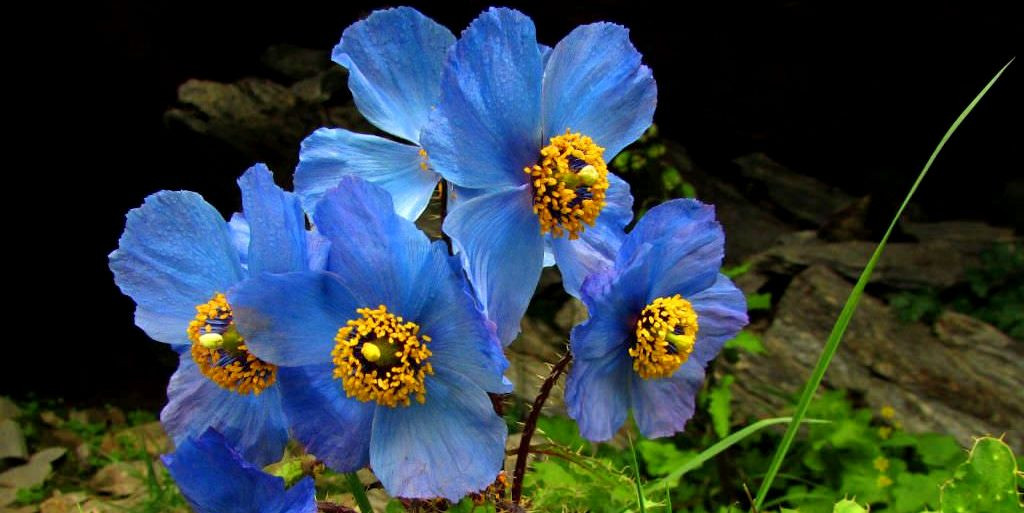
-
Unique Habitat: The Blue Poppy thrives in the moist, alpine regions of the Himalayas, specifically within Bhutan, at altitudes ranging from 3,000 to 4,500 meters. Its preference for high-altitude environments showcases the plant's unique adaptation to cold and rugged terrains, contributing to its rare and ethereal beauty.
-
Striking Appearance: Distinguished by its vivid blue petals, the blue poppy stands out against the natural landscape with a striking burst of color. Its rarity and distinctive hue make it a symbol of the mystique and pristine beauty of the Himalayas, especially during its blooming season in the summer months.
-
Symbolic Significance: Chosen as Bhutan's national flower, the blue poppy reflects the kingdom's deep respect for the natural world and its principles of environmental conservation. It symbolizes resilience, beauty, and the spirit of Bhutan, embodying the country's commitment to preserving its natural heritage.
-
Cultural and Artistic Influence: Beyond its natural allure, the blue poppy influences Bhutanese culture and art, featuring in literature, artwork, and national symbols. Its representation in various cultural expressions underscores its importance to Bhutanese identity and heritage.
-
Conservation Emblem: The Blue Poppy serves as an emblem of Bhutan's environmental efforts, highlighting the importance of biodiversity conservation in the country. Its status as the national flower reinforces Bhutan's global image as a leader in ecological preservation and sustainable living.
-
Tourist Attraction: For trekkers and nature enthusiasts, the sight of the Blue Poppy in its natural habitat is a coveted experience. It attracts visitors to Bhutan's high-altitude regions, promoting eco-tourism and raising awareness about the country's unique flora and fauna.
-
Representation of Bhutanese Values: The Blue Poppy embodies the values of Bhutan, including harmony with nature, sustainability, and the pursuit of happiness. As the national flower, it is a constant reminder of the country's philosophy and way of life, deeply intertwined with the natural environment.
Blue Poppy is not just a plant but a profound symbol of Bhutan's natural beauty, cultural depth, and environmental ethos, representing the essence of the Himalayan kingdom in more ways than one.
Diverse Ecosystems
Bhutan's diverse ecosystems are a testament to the country's unique geographical and climatic conditions, which range from subtropical plains in the south to high Himalayan mountains in the north. This range of habitats supports a remarkable diversity of flora and fauna, making Bhutan a biodiversity hotspot. Here's an overview of the diverse ecosystems found in Bhutan:
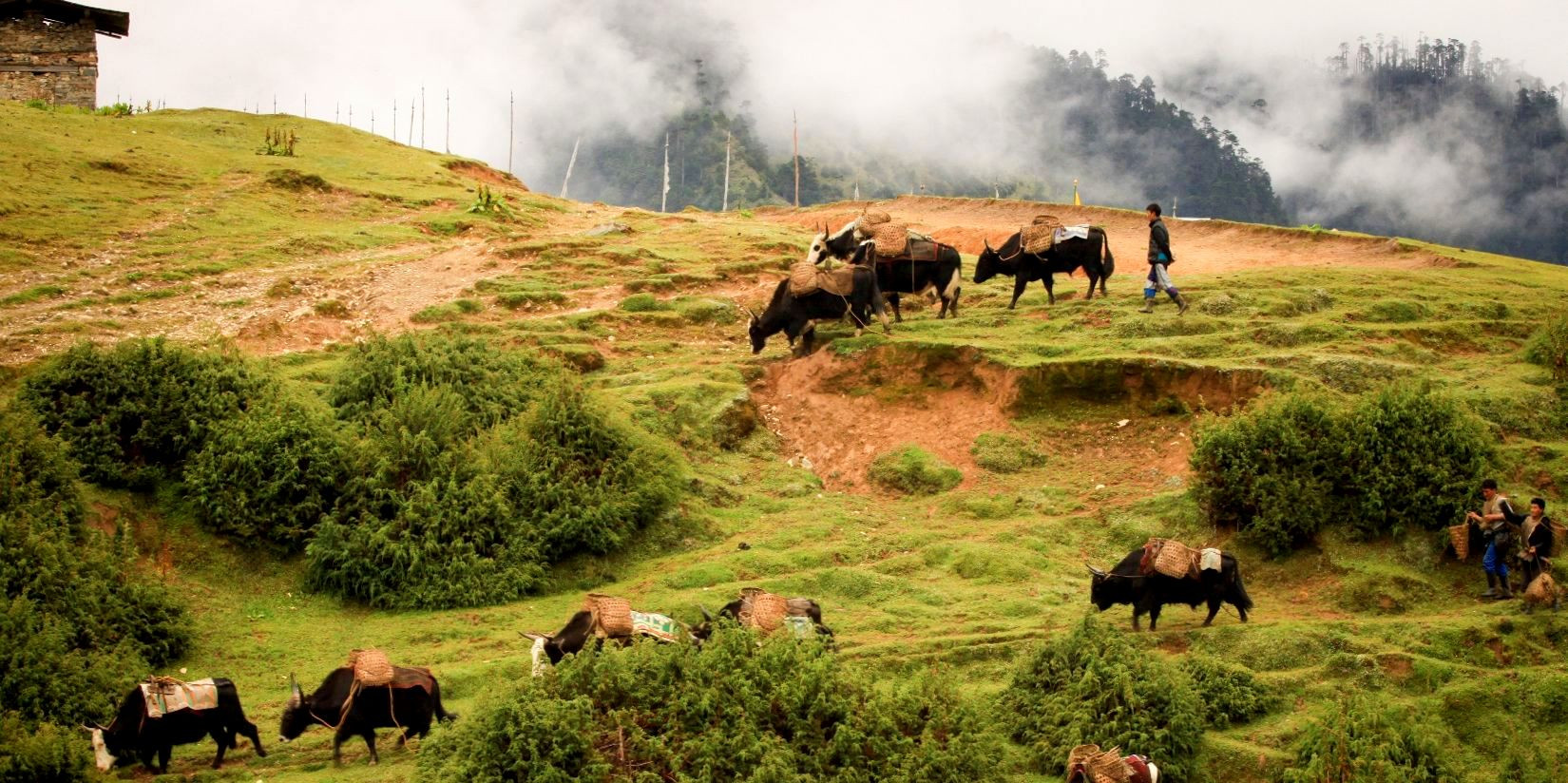
-
Subtropical Forests: Located in the southern regions of Bhutan, these forests experience a warm and humid climate. They are rich in biodiversity, housing a variety of hardwood trees, bamboo, and a plethora of animal species, including elephants, tigers, and numerous bird species.
-
Temperate Forests: As one moves higher into the mid-elevations of Bhutan, the climate becomes cooler, giving way to temperate forests. These forests are characterized by a mix of coniferous and broadleaf species, including oak, maple, and Bhutanese pine. They are home to animals such as red pandas, deer, and leopards.
-
Alpine Zones: The alpine zones of Bhutan, found at the highest elevations, are marked by extreme cold and rugged terrain. Vegetation here is sparse and adapted to harsh conditions, including mosses, lichens, and dwarf shrubs. Iconic species such as the snow leopard, Himalayan blue sheep, and the national flower, the Blue Poppy, thrive in these environments.
-
Riverine Forests: Along the banks of Bhutan's numerous rivers and streams, riverine forests flourish. These areas are crucial for the ecosystem, supporting a variety of plant life and serving as important habitats for fish, birds, and other wildlife.
-
Wetlands: Bhutan's wetlands, including high-altitude lakes and marshes, are vital for biodiversity. They serve as breeding grounds for numerous species of birds, including the black-necked crane, an endangered species that migrates to Bhutan in winter.
-
Protected Areas: To preserve its diverse ecosystems, Bhutan has established a comprehensive network of protected areas, including national parks, wildlife sanctuaries, and nature reserves. These areas are critical for conserving the country's natural heritage and provide safe havens for its flora and fauna.
-
Biological Corridors: Connecting the protected areas are biological corridors, which allow for the free movement of wildlife across different habitats. This innovative approach to conservation helps maintain genetic diversity and ensures the survival of migratory species.
The conservation of these diverse ecosystems is central to Bhutan's environmental policy and its commitment to maintaining a balance between development and nature conservation. This holistic approach has made Bhutan a model for biodiversity conservation globally, preserving the natural beauty and ecological integrity of this Himalayan kingdom.
Endemic Species
Bhutan's unique geographical location and diverse ecosystems have led to the evolution of a range of endemic species, organisms that are found nowhere else on Earth. These species are an integral part of Bhutan's natural heritage and biodiversity. The conservation of these endemic species is crucial, as they often play vital roles in their ecosystems and can be indicators of the health of the environment. Here are some of the notable endemic species of Bhutan:
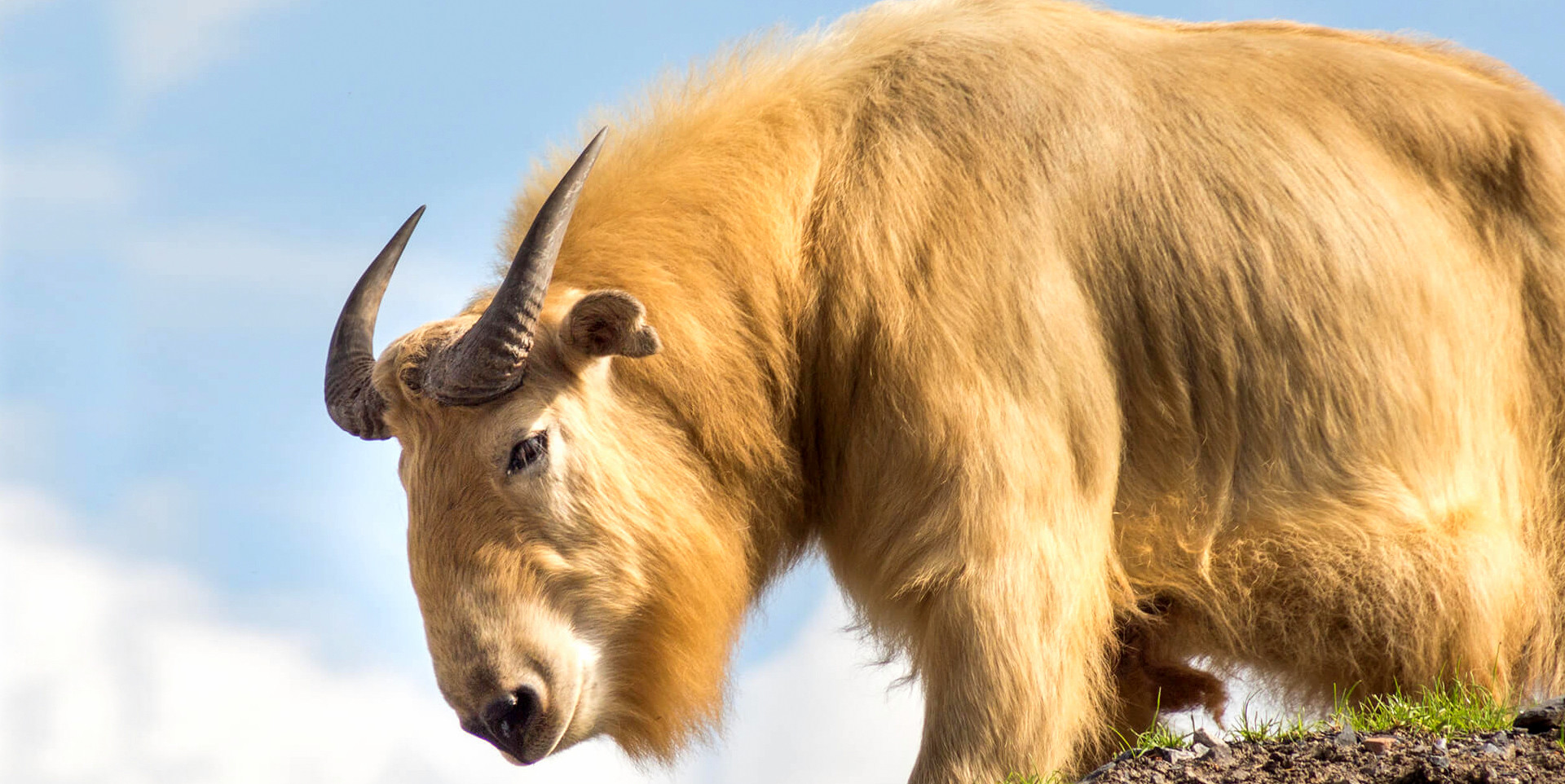
-
Bhutan Takin (Budorcas taxicolor whitei): The Bhutan takin is the national animal of Bhutan, symbolizing the country's rich wildlife and unique biodiversity. This large, goat-antelope creature is found in the bamboo forests and alpine zones of the Himalayas. With its thick fur and unique physical appearance, the takin is well adapted to the rugged terrain and cold climate of high altitudes.
-
Bhutan Glory (Bhutanitis lidderdalii): The Bhutan Glory is a rare species of butterfly endemic to Bhutan. Known for its striking appearance and elusive nature, it inhabits the dense forests of the Eastern Himalayas. The butterfly's unique life cycle and habitat requirements make it a species of interest for conservationists.
-
Bhutan Cypress (Cupressus bhutanica): The Bhutan Cypress is an endemic tree species found in the temperate forests of Bhutan. Revered for its religious significance and used extensively in traditional Bhutanese architecture and ceremonies, this species is integral to Bhutanese culture as well as its forests.
-
Golden Langur (Trachypithecus geei): Although not exclusively endemic to Bhutan (also found in a small region of India), the majority of the golden langur population lives in Bhutan. Known for its distinct golden fur, this primate species inhabits the northern subtropical and temperate forests of Bhutan. It is considered one of the most endangered primate species in the world.
-
Red Panda (Ailurus fulgens): Like the Golden Langur, the Red Panda is not exclusively endemic but is a significant part of Bhutan's unique fauna, found in the temperate forests of the Eastern Himalayas. This species is known for its distinctive reddish-brown fur and bushy tail, and it plays a crucial role in its ecosystem as a seed disperser and bamboo consumer.
The presence of these endemic species highlights the ecological uniqueness of Bhutan and underscores the importance of its conservation efforts. The country's strict environmental policies, including the maintenance of a vast network of protected areas and biological corridors, are critical in preserving these unique species and their habitats. Bhutan's approach to conservation serves as a model for biodiversity preservation worldwide, ensuring that its endemic species continue to thrive for generations to come.
Wildlife Sanctuaries and National Parks
Bhutan’s commitment to environmental conservation is evident in its extensive network of wildlife sanctaries and national parks. These protected areas cover more than half of the country, ensuring the preservation of its rich biodiversity and unique ecosystems. Here’s an overview of some key wildlife sanctuaries and national parks in Bhutan:
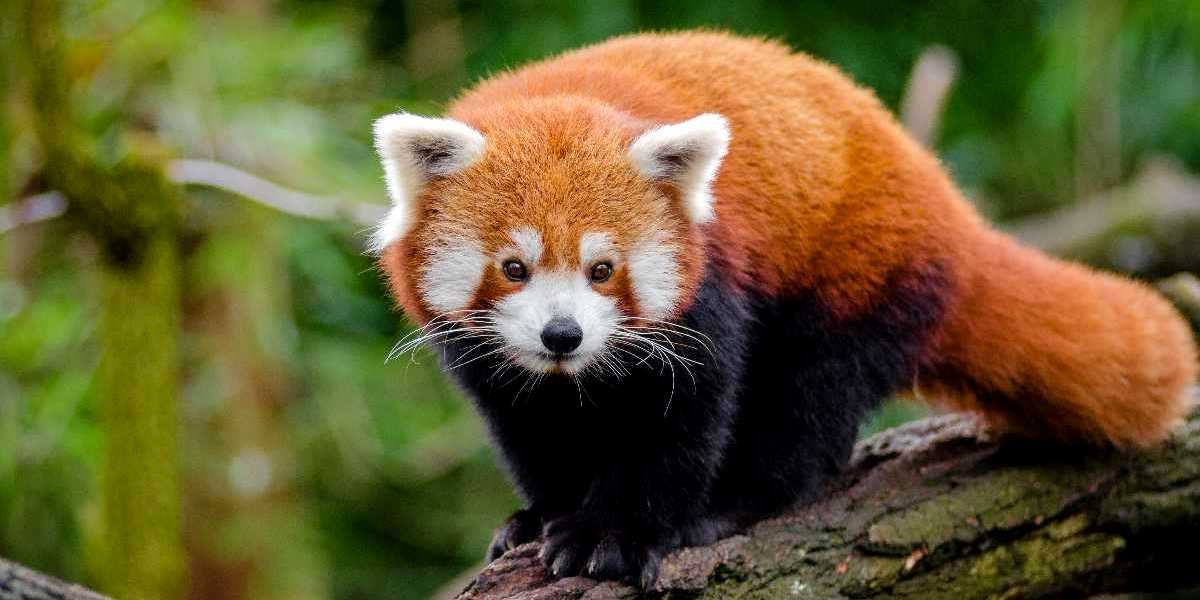
Wildlife Sanctuaries
Jigme Singye Wangchuck National Park
-
Location: Central Bhutan
-
Significance: Named after the fourth king of Bhutan, this park is notable for its diverse ecosystems, ranging from subtropical forests to alpine meadows. It’s a habitat for the Bengal tiger, Himalayan black bear, red panda, and the Bhutan takin.
Sakteng Wildlife Sanctuary
-
Location: Eastern Bhutan
-
Significance: Unique for its protection of the eastern Himalayan ecosystem, it is home to the mythical Yeti (as believed by locals), red panda, Himalayan red fox, and diverse bird species. Sakteng is also known for its rich cultural heritage, being the home of the semi-nomadic Brokpa people.
Phibsoo Wildlife Sanctuary
-
Location: Southern Bhutan
-
Significance: The only place in Bhutan where natural sal (Shorea robusta) forests are found. It shelters the endangered Royal Bengal tiger, Asian elephant, and the unique Chital deer.
National Parks
Jigme Dorji National Park
-
Location: Northwestern Bhutan
-
Significance: The second largest national park in Bhutan, it includes several Bhutanese landmarks, such as the Jomolhari mountain. It is vital for species like the snow leopard, Bengal tiger, takin, and blue sheep. The park is also a critical area for Bhutan’s glacial and water resources.
Royal Manas National Park
-
Location: South-Central Bhutan
-
Significance: Known as the “conservation showpiece of the Kingdom”, it’s the oldest national park in Bhutan. It supports an astounding variety of wildlife, including the Bengal tiger, Asian elephant, greater one-horned rhinoceros, and the rare golden langur.
Bumdeling Wildlife Sanctuary
-
Location: Northeastern Bhutan
-
Significance: An important habitat for the black-necked crane in winter. It also supports other species like the snow leopard, red panda, and various species of birds.
These sanctuaries and parks are integral to Bhutan’s environmental strategy, embodying the nation’s commitment to conservation and sustainable development. They not only protect the natural habitat of countless species but also offer Bhutanese and visitors alike a chance to experience the country’s stunning natural beauty. Through such efforts, Bhutan maintains its status as a global leader in conservation and environmental protection.
Iconic Fauna
Bhutan's rugged landscapes and pristine ecosystems are home to an array of iconic fauna, each species contributing to the rich tapestry of life in this Himalayan kingdom. From elusive big cats to unique ungulates, Bhutan's wildlife is as diverse as its habitats. Here are some of the iconic fauna that inhabits Bhutan:
.jpg)
Bengal Tiger (Panthera tigris tigris)
-
Habitat: Found across various elevations in Bhutan, from the dense jungles in the south to the snowy mountain regions in the north.
-
Conservation Status: Endangered. Bhutan is a key participant in global tiger conservation efforts, providing a safe haven for these majestic big cats.
Snow Leopard (Panthera uncia)
-
Habitat: Resides in the rugged high-altitude regions of the Himalayas.
-
Conservation Status: Vulnerable. The snow leopard is a symbol of the fragile mountain ecosystems of Bhutan, with conservation efforts aimed at protecting its habitat.
Takin (Budorcas taxicolor)
-
Habitat: Prefers the bamboo forests and alpine meadows of the northern and central Bhutanese mountains.
-
Significance: As Bhutan's national animal, the takin is revered and protected, embodying the country's commitment to wildlife conservation.
Black-necked Crane (Grus nigricollis)
-
Habitat: Migrates to Bhutan during the winter, particularly in the Phobjikha Valley.
-
Conservation Status: Near Threatened. The black-necked crane is culturally significant to Bhutanese people, symbolizing longevity and prosperity.
Red Panda (Ailurus fulgens)
-
Habitat: Found in the temperate forests of Bhutan, often in areas with a bamboo understory.
-
Conservation Status: Endangered. The red panda faces threats from habitat loss and fragmentation, making Bhutan's conservation areas critical for its survival.
Golden Langur (Trachypithecus geei)
-
Habitat: Inhabits the subtropical and temperate forests of Bhutan, particularly in the central and southern regions.
-
Conservation Status: Endangered. The golden langur is known for its striking appearance and is one of the most endangered primate species in the world.
Asian Elephant (Elephas maximus)
-
Habitat: Roams the subtropical forests in the southern parts of Bhutan.
-
Conservation Status: Endangered. Asian elephants in Bhutan are part of important conservation efforts to ensure their migration routes and habitats are preserved.
These species, among many others, make Bhutan a remarkable haven for biodiversity. The country's strict environmental policies, including its commitment to maintaining a significant portion of its land under forest cover and establishing protected areas and wildlife sanctuaries, have been instrumental in preserving the habitats and populations of this iconic fauna. Through such efforts, Bhutan not only protects its natural heritage but also contributes significantly to global biodiversity conservation.
Bhutanese Rhododendrons
Bhutanese Rhododendrons are a hallmark of the country's rich floral biodiversity, adding vibrant splashes of color to its lush landscapes. These flowering plants are especially notable for their diversity and beauty, thriving across various altitudes in Bhutan's temperate and subalpine zones. Here's a closer look at these captivating plants:
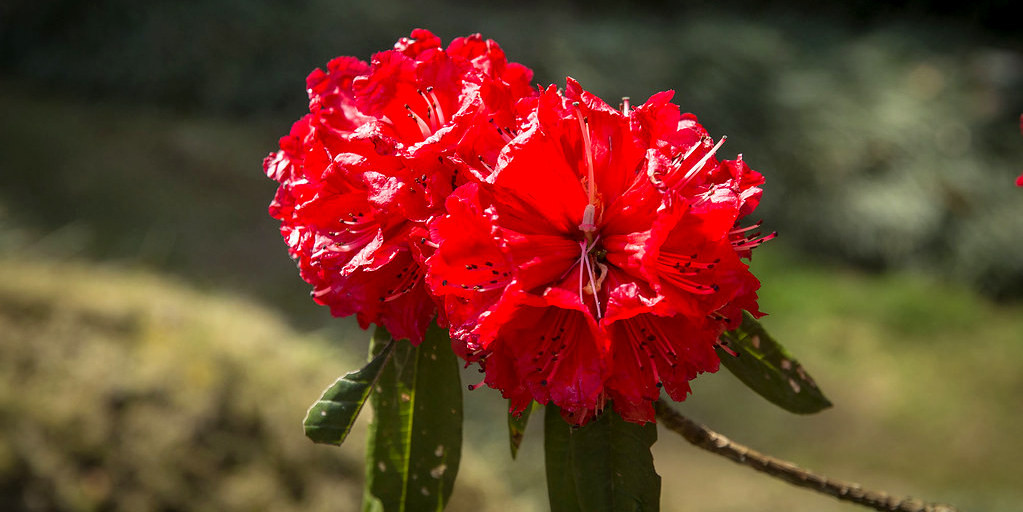
-
Diversity and Distribution: Bhutan is home to over 46 species of rhododendrons, showcasing a wide range of colors, sizes, and shapes. This diversity reflects the varied climates and elevations across the country, from dense forests to misty mountain slopes.
-
Significance: Rhododendrons hold significant cultural value in Bhutan, symbolizing purity and rejuvenation. They are celebrated in local festivals and are deeply intertwined with Bhutanese traditions and folklore.
-
Conservation and Challenges: While many rhododendron species flourish in Bhutan's protected areas, some face threats from habitat loss, climate change, and overcollection. Conservation efforts are crucial to ensuring these plants can continue to be a part of Bhutan's natural heritage.
-
Tourist Attraction: The blooming season, typically from late February to early May, attracts tourists and nature enthusiasts to Bhutan. The Rhododendron Festival, celebrated in the Lamperi Botanical Garden, is a testament to the beauty and ecological importance of these flowers, offering visitors a chance to immerse themselves in the country's natural splendor.
-
Research and Preservation: Ongoing research efforts aim to catalog and study Bhutan's rhododendron species, contributing to the global understanding of these plants. Preservation initiatives focus on sustainable practices to protect these flowers for future generations, emphasizing Bhutan's commitment to environmental stewardship.
Bhutanese Rhododendrons, with their stunning diversity and ecological importance, are a symbol of the country's commitment to preserving its unique biodiversity. They embody the natural beauty and ecological richness that Bhutan is known for, making them a key feature of its environmental and cultural landscape.
Medicinal Plants
Bhutan's rich biodiversity includes a vast array of medicinal plants, deeply embedded in the traditional healthcare practices of the country. With over 300 species of medicinal plants recorded, these natural resources play a crucial role in Bhutanese culture, health, and well-being. Here's an overview of Bhutan's medicinal plants and their significance:
 3.jpg)
Variety and Habitat
-
Bhutan's medicinal plants range from high-altitude herbs and shrubs to tropical and subtropical species found in the lush valleys and forests. This diversity is attributed to Bhutan's varied climate zones and pristine environments.
-
Many of these plants are harvested from wild habitats, including remote alpine meadows and dense forests, which are considered clean and unpolluted, contributing to the potency and purity of the medicinal properties.
Traditional Bhutanese Medicine (Sowa Rigpa)
-
Sowa Rigpa: Traditional Bhutanese medicine, known as Sowa Rigpa, is an ancient practice that integrates physical, emotional, and spiritual well-being. Medicinal plants are fundamental to Sowa Rigpa, used in various forms such as powders, pills, teas, and ointments.
-
Institutions: The National Institute of Traditional Medicine in Bhutan is dedicated to preserving and promoting the knowledge and use of medicinal plants. It trains traditional medicine practitioners and conducts research on the medicinal properties of local flora.
Key Medicinal Plants and Their Uses
-
Aconitum spp. (Aconite): Used for its analgesic and anti-inflammatory properties but requires careful handling due to its toxicity.
-
Rhododendron spp.: Various species have applications in treating digestive disorders and as anti-inflammatories.
-
Terminalia chebula (Chebulic Myrobalan): Revered for its wide-ranging health benefits, including digestive health, detoxification, and rejuvenation.
-
Picrorhiza kurrooa (Kutki): is known for its liver-protective and immune-modulating effects.
Conservation and Sustainable Use
-
With the increasing demand for natural remedies and the overharvesting of certain species, Bhutan emphasizes the sustainable use and conservation of medicinal plants. Efforts include cultivation projects and education on sustainable harvesting techniques.
-
Bhutan's protected areas and biodiversity policies also play a crucial role in preserving the habitats of these valuable plants, ensuring they continue to thrive for future generations.
Cultural and Economic Importance
-
Beyond their health benefits, medicinal plants are integral to Bhutan's cultural heritage, used in religious and spiritual practices.
-
They also contribute to the rural economy, with many communities involved in the sustainable collection and sale of medicinal herbs.
Bhutan's medicinal plants are a testament to the country's rich natural heritage and the traditional knowledge that has been passed down through generations. As Bhutan continues to balance modern healthcare with traditional practices, the importance of these plants in the well-being of its people remains undisputed, embodying the holistic approach to life that is central to Bhutanese philosophy.
Bird's Paradise
Bhutan, often celebrated as a "Bird Paradise," is an essential haven for bird enthusiasts and ornithologists worldwide. Its diverse ecosystems, ranging from subtropical forests to alpine meadows, provide ideal habitats for over 670 species of birds, making it a significant site for avian biodiversity in the Eastern Himalayas. Here's why Bhutan is considered a birdwatcher's paradise:
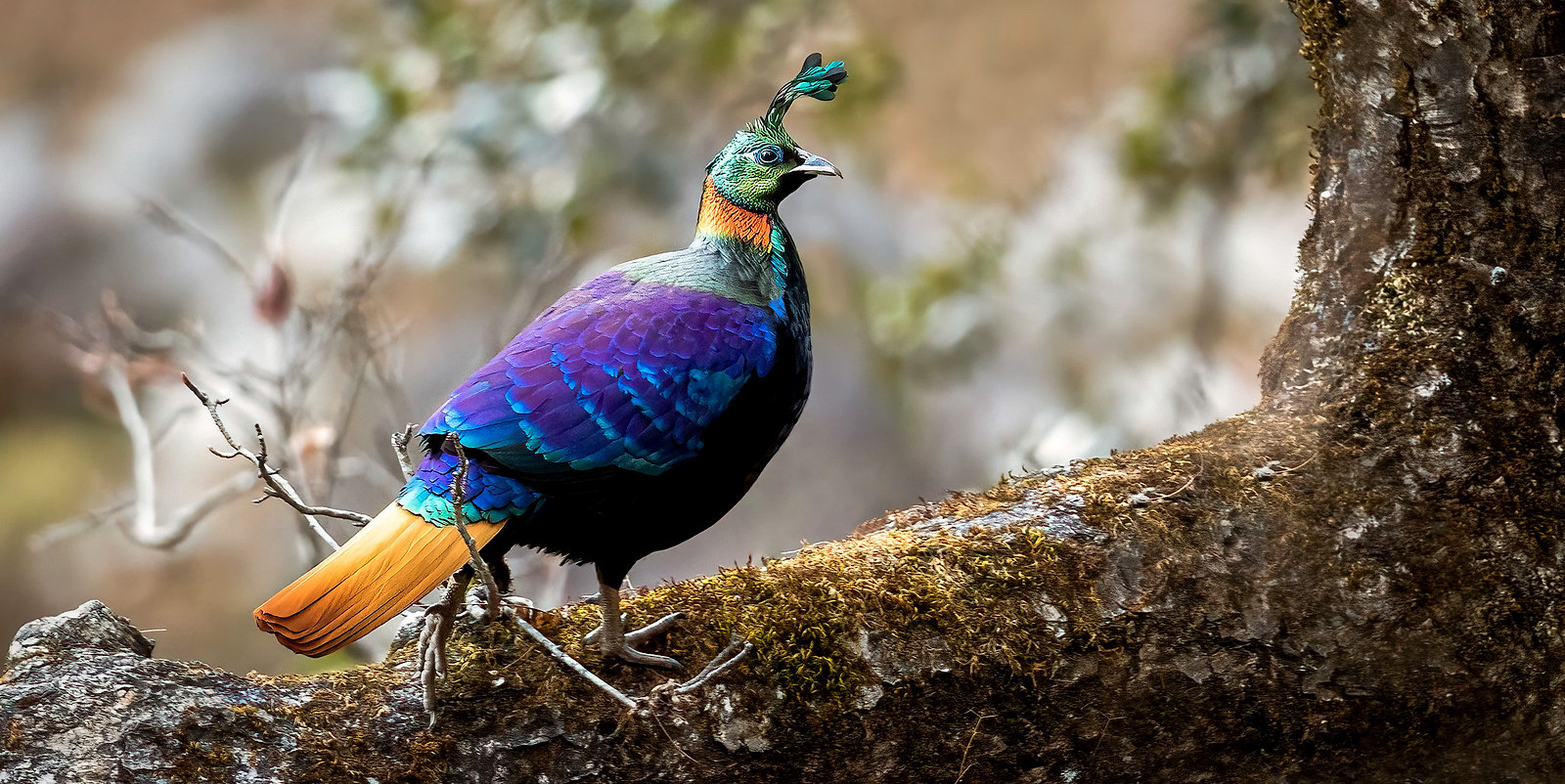
-
Varied Ecosystems Support Diverse Avifauna: Bhutan's varied climates and untouched natural habitats create perfect conditions for a wide range of bird species, including residents, migrants, and those endemic to the Eastern Himalayan region. From the rare Black-necked Crane to the vibrant Himalayan Monal, Bhutan's bird diversity is unparalleled.
-
Important Bird and Biodiversity Areas (IBAs): The country has several Important Bird and Biodiversity Areas (IBAs) recognized internationally. These areas are critical for the conservation of bird populations and their habitats, ensuring that species of global conservation concern are protected.
-
Conservation Initiatives Enhance Avian Habitats: Bhutan's commitment to maintaining a minimum of 60% forest cover and its network of protected areas and biological corridors contribute significantly to the preservation of bird habitats. These conservation efforts provide safe breeding and foraging grounds for a myriad of bird species.
-
Unique Birding Experiences: Bhutan offers unique birding experiences due to its remote and pristine environments. Birdwatchers have the opportunity to observe rare and exotic birds in their natural habitats, often accompanied by stunning natural backdrops. Species such as the Satyr Tragopan, Ward's Trogon, and the beautiful Nuthatch can be spotted.
-
Cultural Significance of Birds: Birds hold a special place in Bhutanese culture and mythology, adding an additional layer of significance to birdwatching in Bhutan. The Black-necked Crane, for example, is revered and celebrated in local festivals, symbolizing longevity and prosperity.
-
Eco-Tourism and Birdwatching Tours: Bhutan promotes eco-tourism, including specialized birdwatching tours that cater to enthusiasts keen on observing Bhutan's avian wealth. These tours are designed to be sustainable, minimizing impact on the environment while providing educational and conservation-oriented experiences.
-
Research and Monitoring: Ongoing research and monitoring efforts help in understanding bird populations, migration patterns, and the impacts of climate change on avian species. These initiatives are crucial for the long-term conservation of Bhutan's bird diversity.
-
Challenges and Conservation Efforts: Despite Bhutan's successful conservation efforts, challenges such as habitat loss, climate change, and human-wildlife conflict pose threats to its avian populations. Bhutan continues to address these challenges through stringent conservation policies, habitat restoration efforts, and community engagement in bird conservation.
Bhutan's rich avian biodiversity, combined with its robust conservation measures and the unique opportunity to observe rare birds in their natural habitats, truly makes it a bird paradise. For birdwatchers and nature lovers, Bhutan represents an unparalleled destination where the beauty and diversity of bird life can be appreciated in harmony with nature's serenity.
Bhutan's approach to preserving its unique flora and fauna stands as a testament to its commitment to environmental conservation and sustainable living. By maintaining extensive forest cover and establishing protected areas, Bhutan not only safeguards its rich biodiversity, including species like the Blue Poppy and snow leopard, but also sets a global example for integrating conservation with national policy and cultural values. This small Himalayan kingdom demonstrates the power of prioritizing nature, offering lessons in harmony and sustainability that resonate worldwide.
FAQs for Bhutan's Unique Flora and Fauna
Q: What is the national flower of Bhutan?
A: The national flower of Bhutan is the Blue Poppy (Meconopsis gakyidiana), known for its striking blue petals. It blooms in the high-altitude areas from late spring to early summer.
Q: Can you find the Bengal tiger in Bhutan?
A: Yes, the Bengal tiger is found in Bhutan, ranging across various habitats from the subtropical forests to the alpine zone, making Bhutan one of the few places in the world where tigers are found at high altitudes.
Q: What is Bhutan's national animal, and where can it be found?
A: The Takin (Budorcas taxicolor) is Bhutan's national animal. This unique bovid species can be found in the bamboo forests and alpine meadows of Bhutan’s mountains.
Q: Are there any endangered species in Bhutan?
A: Yes, Bhutan is home to several endangered species, including the snow leopard, red panda, and the black-necked crane, all of which are under conservation efforts to protect their populations and habitats.
Q: How does Bhutan contribute to wildlife conservation?
A: Bhutan contributes to wildlife conservation through its extensive network of protected areas, conservation policies embedded within its constitution, and efforts such as maintaining over 60% of its land under forest cover and establishing biological corridors for wildlife movement.
Q: What makes Bhutan a bird paradise?
A: Bhutan's diverse ecosystems support over 670 bird species, making it a birdwatcher's paradise. Its pristine environment, ranging from subtropical to alpine, provides ideal habitats for a wide variety of birds, including many rare and endangered species.
Q: How are medicinal plants used in Bhutan?
A: Medicinal plants in Bhutan are integral to Traditional Bhutanese Medicine (Sowa Rigpa), used in various forms for healing and wellness. Over 300 species of medicinal plants have been identified, highlighting the country's rich biodiversity.
Q: Why is Bhutan considered unique in terms of its flora and fauna?
A: Bhutan's unique position in the Himalayas, its varied climatic zones, untouched natural environments, and strong conservation ethos make it a haven for unique flora and fauna, including endemic species, and offer a model for biodiversity conservation worldwide.
Q: What challenges does Bhutan face in conserving its biodiversity?
A: Challenges include habitat degradation, climate change, and human-wildlife conflict. However, Bhutan addresses these through comprehensive conservation strategies, community engagement, and sustainable development practices.
Q: Can tourists visit Bhutan's wildlife sanctuaries and national parks?
A: Yes, tourists can visit Bhutan's wildlife sanctuaries and national parks, but they are often required to be accompanied by licensed guides or be part of organized tours to ensure minimal impact on the environment and respect for conservation efforts.
If you are looking for different kinds of Nepal Tours or Trekking Packages, feel free to contact us.
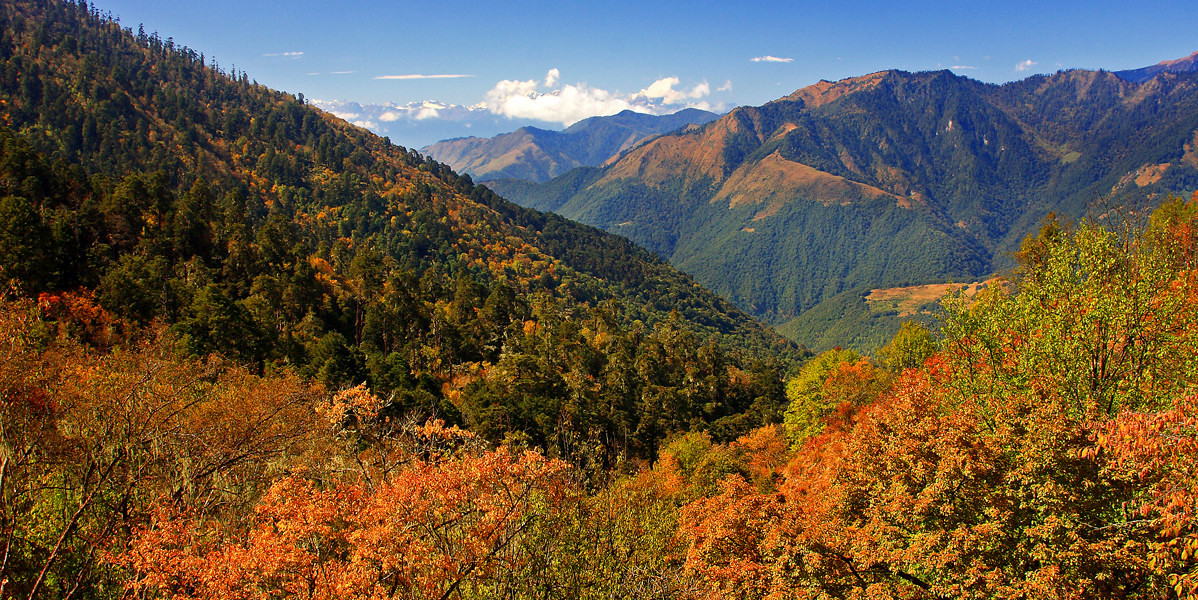





.jpg)

 3.jpg)
